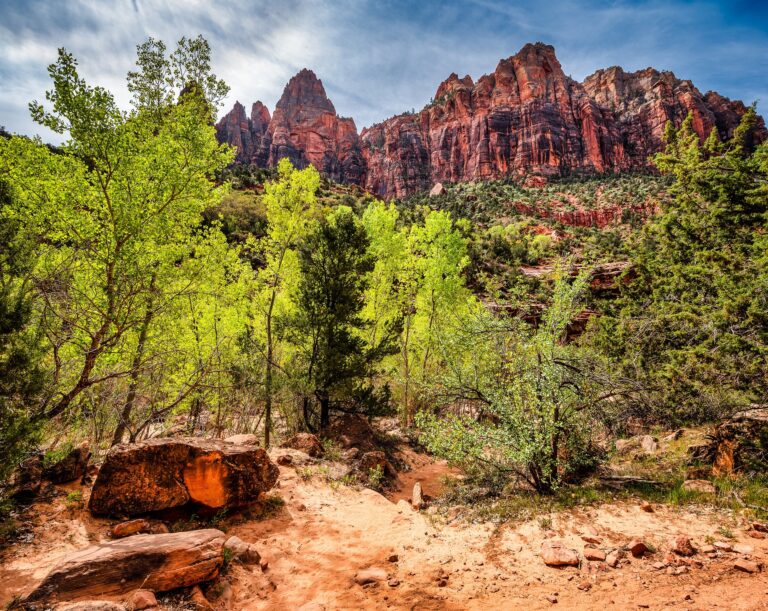Welcome to Zion National Park, a sanctuary of awe-inspiring natural wonders and extraordinary beauty. Nestled in the southwestern corner of Utah, Zion National Park is renowned for its striking gorge carved by the Virgin River, and Angels Landing, an iconic hiking trail that leads to a breathtaking viewpoint. Zion National Park spans over 229 square miles, making it one of the largest national parks in the United States.
Before you embark on an adventure to Zion National Park, there are some amazing facts about the National Park that are worthy of knowing. Learning about these majestic places deepens our appreciation and connection to the amazing world around us. And Zion’s story starts millions of years ago.
In this article, we will discover ten amazing facts about Zion National Park that will enrich your understanding for this extraordinary place. From its iconic trails and stunning landscapes to its rich history and diverse wildlife, there is much to discover and explore in this expansive oasis of beauty. So, lace up your hiking boots, pack your sense of adventure, and let us unveil the wonders that await you in Zion National Park.
Native Americans inhabited Zion
Zion National Park holds a rich cultural history, with several Native American tribes having a connection to the land for thousands of years. The Southern Paiute people, known as the Nuwuvi, have ancestral ties to the Zion region. They have long revered the area as a sacred landscape and consider it a part of their creation story. The Southern Paiute’s deep spiritual and cultural connection to the land is evident in their stories, songs, and traditions passed down through generations.
Additionally, the Ancestral Puebloans, also known as the Anasazi, inhabited the area centuries ago. Evidence of their presence can be seen in the park through petroglyphs and artifacts. Their dwellings and agricultural practices reflect their ability to adapt and thrive in the region’s challenging environment. Exploring Zion National Park offers an opportunity to appreciate and learn from the ancestral heritage of these Native American tribes, acknowledging their deep-rooted connection to the land and their lasting impact on the region’s cultural landscape.
Evidence of humans in Zion for thousands of years
The oldest known artifact found in Zion National Park is a projectile point made of chert, a type of stone. This particular projectile point, known as the Mesquite Flat Point, dates back approximately 6,000 to 8,000 years. It was discovered in the lower Zion Canyon area during archaeological excavations. The Mesquite Flat Point is a significant find as it provides evidence of human occupation and activity in the area during ancient times. It serves as a testament to the long history of human presence and the rich cultural heritage that spans thousands of years in Zion National Park.
The name Zion came from mormon settlers
Zion National Park derives its name from the majestic and awe-inspiring landscapes that early Mormon settlers encountered in the area. In the mid-1800s, these settlers referred to the region as “Zion,” a biblical term signifying a place of refuge or sanctuary. The name was chosen to reflect the area’s natural beauty and spiritual significance. As time passed, the name became synonymous with the park, which was established in 1919, and it continues to evoke a sense of reverence and wonder for the stunning red rock canyons, towering cliffs, and diverse ecosystems that define Zion National Park.
Zion has well preserved beauty
Zion National Park stands as a testament to the remarkable preservation of its natural wonders, largely due to its unique geographic location. Situated in the southwestern United States, Zion benefits from its remote and rugged setting, which has helped shield it from excessive human impact and development. The park’s expansive canyons, towering sandstone cliffs, and pristine ecosystems have remained remarkably intact over the years, allowing visitors to witness the same awe-inspiring landscapes that have captivated generations. The park’s commitment to conservation and responsible management, coupled with its remote location, has contributed to the preservation of its extraordinary natural beauty, making Zion a sanctuary of unparalleled splendor.
Visitors can explore Zion National Park by using the park’s shuttle system, which helps reduce congestion and preserve the natural environment. The shuttle provides easy access to popular trailheads, viewpoints, and attractions within the park.
World renowned hiking trail in Zion
Angel’s Landing is a renowned and exhilarating hike in Zion National Park, offering breathtaking panoramic views. Starting at the Grotto Trailhead, the trail ascends steeply with a series of switchbacks known as Walter’s Wiggles. The highlight of the hike is the final section, the Hogsback, where hikers traverse along a narrow ridge with chains for added safety. From the summit, visitors are rewarded with stunning vistas of Zion Canyon, including the winding Virgin River and towering sandstone cliffs. The hike is challenging and not recommended for those with a fear of heights, but for experienced hikers, it offers an unforgettable adventure and a profound sense of accomplishment.
Proper footwear, ample water, and caution are essential, and starting early is advisable to avoid crowds. Angel’s Landing is a must-do experience, combining awe-inspiring scenery, thrilling moments, and the unparalleled beauty of Zion National Park.
Zion is extremely biodiverse
Zion National Park is a haven for diverse plant and animal species, showcasing the remarkable adaptability of life in its unique ecosystems. From the arid desert lowlands to the verdant high plateaus, the park’s landscapes support a rich tapestry of flora and fauna. Desert-adapted plants such as prickly pear cacti and yucca dot the arid terrain, while higher elevations are adorned with majestic forests of ponderosa pines and Douglas firs. Among the park’s iconic residents are the graceful mule deer, often spotted gracefully roaming through meadows and along rocky slopes. And keep your eyes peeled for the awe-inspiring desert bighorn sheep, known for their impressive horns and agile climbing abilities. Marvel at the soaring golden eagles overhead and be on the lookout for the magnificent California condor, a symbol of conservation success. With such an abundance of plant and animal life, a visit to Zion is a captivating opportunity to witness the intricate web of biodiversity that thrives within this pristine wilderness.
Zion is a stargazing haven
Zion National Park holds the prestigious designation of being an International Dark Sky Park, signifying its commitment to preserving the natural beauty of the night sky. This distinction is a testament to the park’s efforts in minimizing light pollution and creating an optimal environment for stargazing and astronomical observations. The dark skies of Zion provide a captivating canvas for stargazers, where countless stars, planets, and celestial wonders illuminate the night. Visitors are treated to awe-inspiring views of the Milky Way stretching across the heavens, meteor showers lighting up the darkness, and the tranquil beauty of the moon casting its gentle glow over the canyon walls. With its remote location and careful management of artificial lighting, Zion National Park offers a unique opportunity to connect with the wonders of the universe and experience the magic of a pristine night sky. It is a haven for astronomers, astrophotographers, and all those seeking to immerse themselves in the celestial splendor of our cosmos.
Shaped over millions of years
Carving through the sandstone cliffs of Zion Canyon, the Virgin River has slowly shaped the breathtaking landscape of Zion National Park over millions of years. This river is a lifeline for the park’s ecosystem, providing water for the diverse plant and animal life that inhabit its banks. One of the most iconic aspects of the Virgin River is the Narrows, a section where the canyon walls narrow dramatically, creating a stunning hiking experience. Visitors can wade through the river, surrounded by towering cliffs on either side. It’s an unforgettable adventure that allows you to immerse yourself in the awe-inspiring beauty of the canyon. However, it’s essential to be mindful of weather conditions and potential flash floods, as the river can rapidly rise. The Virgin River is not only a scenic wonder but also a vital force that has sculpted Zion National Park into the natural masterpiece it is today.
Several movies filmed on location in Zion
While several movies have showcased the majestic beauty of Zion National Park, one of the most notable films shot in the area is the 1969 classic, “Butch Cassidy and the Sundance Kid.” The iconic final scene, where the outlaws make their ill-fated leap into the roaring river, was filmed in Zion. The park has also been a backdrop for other notable productions, such as “Transformers: Age of Extinction” and “127 Hours,” which depicts the harrowing true story of a hiker’s survival. These films highlight the captivating scenery of Zion, capturing its grandeur and contributing to its cinematic legacy.
Zion as a natural wonder of beauty
Zion National Park is renowned for its breathtaking natural beauty, and there are several locations within the park that are often regarded as exceptionally stunning. One of the most iconic and visually captivating areas is the Zion Canyon, particularly the section known as the Temple of Sinawava. Here, visitors are greeted by towering sandstone cliffs, the tranquil Virgin River flowing through the canyon, and the beginning of the spectacular Narrows hike. The lush vegetation, dramatic rock formations, and the interplay of light and shadow create a mesmerizing landscape that is often considered one of the most beautiful spots in Zion. Additionally, locations like Angels Landing, the Emerald Pools, and the Court of the Patriarchs offer their own unique charm and scenic splendor, making Zion National Park a haven for nature lovers and photographers alike.
As you venture forth into the extraordinary realm of Zion National Park, armed with these ten amazing facts, may your journey be one of awe, discovery, and connection with the untamed wonders of nature. From the soaring cliffs and enchanting canyons to the vibrant wildlife and rich cultural heritage, Zion offers a tapestry of experiences that will leave an indelible mark on your soul. Embrace the spirit of exploration, immerse yourself in the splendor of this natural sanctuary, and let the magic of Zion unfold before your eyes.


